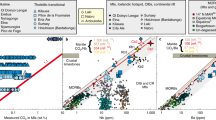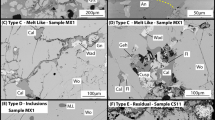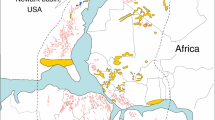Abstract
Long-term cycles in Earth’s climate are thought to be primarily controlled by changes in atmospheric CO2 concentrations. Changes in carbon emissions from volcanic activity can create an imbalance in the carbon cycle. Large-scale changes in volcanic activity have been inferred from proxies such as the age abundance of detrital zircons, but the magnitude of carbon emissions depends on the style of volcanism as well as the amount. Here we analyse U–Pb age and trace element data of detrital zircons from Antarctica and compare the results with the global rock record. We identify a spike in CO2-rich carbonatite and alkaline magmatism during the Ediacaran period. Before the Ediacaran, secular cooling of the mantle and the advent of cooler subduction regimes promoted the sequestration of carbon derived from decarbonation of subducting oceanic slabs in the mantle. We infer that subsequent magmatism led to the extensive release of carbon that may at least in part be recorded in the Shuram–Wonoka carbon isotope excursion. We therefore suggest that this pulse of alkaline volcanism reflects a profound reorganization of the Neoproterozoic deep and surface carbon cycles and promoted planetary warming before the Cambrian radiation.
This is a preview of subscription content, access via your institution
Access options
Access Nature and 54 other Nature Portfolio journals
Get Nature+, our best-value online-access subscription
$29.99 / 30 days
cancel any time
Subscribe to this journal
Receive 12 print issues and online access
$259.00 per year
only $21.58 per issue
Buy this article
- Purchase on Springer Link
- Instant access to full article PDF
Prices may be subject to local taxes which are calculated during checkout



Similar content being viewed by others
References
Dasgupta, R. Ingassing, storage, and outgassing of terrestrial carbon through geologic time. Rev. Mineral. Geochem. 75, 183–229 (2013).
Berner, R. Atmospheric carbon dioxide levels over Phanerozoic time. Science 249, 1382–1386 (1990).
Hoffman, P. F., Kaufman, A. J., Halverson, G. P. & Schrag, D. P. A Neoproterozoic snowball Earth. Science 281, 1342–1346 (1998).
Fike, D. A., Grotzinger, J. P., Pratt, L. M. & Summons, R. E. Oxidation of the Ediacaran ocean. Nature 444, 744–747 (2006).
McKenzie, N. R., Hughes, N. C., Gill, B. C. & Myrow, P. M. Plate tectonic influences on Neoproterozoic–early Paleozoic climate and animal evolution. Geology 42, 127–130 (2014).
McKenzie, N. R. et al. Continental arc volcanism as the principal driver of icehouse-greenhouse variability. Science 352, 444–447 (2016).
Lee, C. T. A. et al. Continental arc-island arc fluctuations, growth of crustal carbonates, and long-term climate change. Geosphere 9, 21–36 (2013).
Edmond, J. M. & Huh, Y. Non-steady state carbonate recycling and implications for the evolution of atmospheric \({p}_{{{\rm{CO}}}_{{\rm{2}}}}\). Earth Planet. Sci. Lett. 216, 125–139 (2003).
Caldeira, K. Enhanced Cenozoic chemical-weathering and the subduction of pelagic carbonate. Nature 357, 578–581 (1992).
Kerrick, D. M. Present and past nonanthropogenic CO2 degassing from the solid earth. Rev. Geophys. 39, 565–585 (2001).
Santosh, M. & Omori, S. CO2 windows from mantle to atmosphere: models on ultrahigh-temperature metamorphism and speculations on the link with melting of snowball Earth. Gondwana Res. 14, 82–96 (2008).
Hammouda, T. & Keshav, S. Melting in the mantle in the presence of carbon: review of experiments and discussion on the origin of carbonatites. Chem. Geol. 418, 171–188 (2015).
Rukhlov, A. S., Bell, K. & Amelin, Y. Carbonatites, isotopes and evolution of the subcontinental mantle: an overview. in Symp. Crit. Strateg. Mat. 39–64 (British Columbia Geological Survey Paper 2015–3, BC Geological Survey, 2015).
Wallace, P. J. Volatiles in subduction zone magmas: concentrations and fluxes based on melt inclusion and volcanic gas data. J. Volcanol. Geotherm. Res. 140, 217–240 (2005).
Bailey, D. K. & Hampton, C. M. Volatiles in alkaline magmatism. Lithos 26, 157–165 (1990).
Woolley, A. R. & Kemp, D. R. C. in Carbonatites: Genesis and Evolution (ed. Bell, K.) 1–14 (Unwin Hyman, London, 1989).
Hudgins, T. R., Mukasa, S. B., Simon, A. C., Moore, G. & Barifaijo, E. Melt inclusion evidence for CO2-rich melts beneath the western branch of the East African Rift: implications for long-term storage of volatiles in the deep lithospheric mantle. Contrib. Mineral. Petrol. 169, 1–18 (2015).
Goodge, J. W., Fanning, C. M., Norman, M. D. & Bennett, V. C. Temporal, isotopic and spatial relations of Early Paleozoic Gondwana-margin arc magmatism, Central Transantarctic Mountains, Antarctica. J. Petrol. 53, 2027–2065 (2012).
Hagen-Peter, G., Cottle, J. M., Smit, M. & Cooper, A. F. Coupled garnet Lu–Hf and monazite U–Pb geochronology constrain early convergent margin dynamics in the Ross orogen, Antarctica. J. Metamorph. Geol. 34, 293–319 (2016).
Paulsen, T. S., Deering, C., Sliwinski, J., Bachmann, O. & Guillong, M. A continental arc tempo discovered in the Pacific-Gondwana margin mudpile? Geology 44, 915–918 (2016).
Squire, R. J., Campbell, I. H., Allen, C. M. & Wilson, C. J. L. Did the Transgondwanan Supermountain trigger the explosive radiation of animals on Earth? Earth Planet. Sci. Lett. 250, 116–133 (2006).
Pilet, S., Baker, M. B. & Stolper, E. M. Metasomatized lithosphere and the origin of alkaline lavas. Science 320, 916–919 (2008).
Belousova, E. A., Griffin, W. L., O’Reilly, S. Y. & Fisher, N. I. Igneous zircon: trace element composition as an indicator of source rock type. Contrib. Mineral. Petrol. 143, 602–622 (2002).
Cawood, P. A., Hawkesworth, C. J. & Dhuime, B. The continental record and the generation of continental crust. Bull. Geol. Soc. Am. 125, 14–32 (2013).
Veevers, J. J. Pan-Gondwanaland post-collisional extension marked by 650–500 Ma alkaline rocks and carbonatites and related detrital zircons: a review. Earth Sci. Rev. 83, 1–47 (2007).
Woolley, A. R. & Bailey, D. K. The crucial role of lithospheric structure in the generation and release of carbonatites: geological evidence. Mineral. Mag. 76, 259–270 (2012).
Stern, R. J., Leybourne, M. I. & Tsujimori, T. Kimberlites and the start of plate tectonics. Geology 44, 1–4 (2016).
Bell, K. & Simonetti, A. Source of parental melts to carbonatites — critical isotopic constraints. Mineral. Petrol. 98, 77–89 (2010).
Hulett, S. R. W., Simonetti, A., Rasbury, E. T. & Hemming, N. G. Recycling of subducted crustal components into carbonatite melts revealed by boron isotopes. Nat. Geosci. 9, 9–14 (2016).
Tsujimori, T. & Ernst, W. G. Lawsonite blueschists and lawsonite eclogites as proxies for palaeo-subduction zone processes: a review. J. Metamorph. Geol. 32, 437–454 (2014).
Liou, J. G., Tsujimori, T., Yang, J., Zhang, R. Y. & Ernst, W. G. Recycling of crustal materials through study of ultrahigh-pressure minerals in collisional orogens, ophiolites, and mantle xenoliths: a review. J. Asian Earth Sci. 96, 386–420 (2014).
Brown, M. Metamorphic conditions in orogenic belts: a record of secular change. Int. Geol. Rev. 49, 193–234 (2007).
Horton, F. Did phosphorus derived from the weathering of large igneous provinces fertilize the Neoproterozoic ocean? Geochem. Geophys. Geosyst. 16, 1723–1738 (2015).
Woolley, A. R. in Carbonatites: Genesis and Evolution 15–37 (Unwin Hyman, London, 1989).
Hagen-Peter, G. & Cottle, J. M. Synchronous alkaline and subalkaline magmatism during the late Neoproterozoic–early Paleozoic Ross orogeny, Antarctica: insights into magmatic sources and processes within a continental arc. Lithos 262, 677–698 (2016).
Gernon, T. M., Hincks, T. K., Tyrrell, T., Rohling, E. J. & Palmer, M. R. Snowball Earth ocean chemistry driven by extensive ridge volcanism during Rodinia breakup. Nat. Geosci. 9, 242–248 (2016).
Doig, R. An alkaline rock province linking Europe and North America. Can. J. Earth Sci. 22, 22–28 (1970).
Tappe, S. et al. Genesis of ultramafic lamprophyres and carbonatites at Aillik Bay, Labrador: a consequence of incipient lithospheric thinning beneath the North Atlantic Craton. J. Petrol. 47, 1261–1315 (2006).
Payne, J. L. et al. Calcium isotope constraints on the end-Permian mass extinction. Proc. Natl Acad. Sci. USA 107, 8543–8548 (2010).
Storey, M., Duncan, R. A. & Swisher, C. C. Paleocene-Eocene thermal maximum and the opening of the Northeast Atlantic. Science 316, 587–589 (2007).
Cox, G. M. et al. Continental flood basalt weathering as a trigger for Neoproterozoic Snowball Earth. Earth Planet. Sci. Lett. 446, 89–99 (2016).
Grotzinger, J. P., Fike, D. A. & Fischer, W. W. Enigmatic origin of the largest-known carbon isotope excursion in Earth’s history. Nat. Geosci. 4, 285–292 (2011).
Husson, J. M., Maloof, A. C., Schoene, B., Chen, C. Y. & Higgins, J. A. Stratigraphic expression of Earth’s deepest δ13C excursion in the Wonoka Formation of South Australia. Am. J. Sci. 315, 1–45 (2015).
Derry, L. A. A burial diagenesis origin for the Ediacaran Shuram–Wonoka carbon isotope anomaly. Earth Planet. Sci. Lett. 294, 152–162 (2010).
Lee, C., Love, G. D., Fischer, W. W., Grotzinger, J. P. & Halverson, G. P. Marine organic matter cycling during the Ediacaran Shuram excursion. Geology 43, 1103–1106 (2015).
Minguez, D. & Kodama, K. P. Rock magnetic chronostratigraphy of the Shuram carbon isotope excursion: Wonoka Formation, Australia. Geology 45, 567–570 (2017).
Deines, P. The carbon isotope geochemistry of mantle xenoliths. Earth Sci. Rev. 58, 247–278 (2002).
Rothman, D. H., Hayes, J. M. & Summons, R. E. Dynamics of the Neoproterozoic carbon cycle. Proc. Natl Acad. Sci. USA 100, 8124–8129 (2003).
Pu, J. P. et al. Dodging snowballs: geochronology of the Gaskiers glaciation and the first appearance of the Ediacaran biota. Geology 44, 955–958 (2016).
Hall, C. E., Cooper, A. F. & Parkinson, D. L. Early Cambrian carbonatite in Antarctica. J. Geol. Soc. Lond. 152, 721–728 (1995).
Casquet, C. et al. A deformed alkaline igneous rock-carbonatite complex from the Western Sierras Pampeanas, Argentina: evidence for late Neoproterozoic opening of the Clymene Ocean? Precambr. Res. 165, 205–220 (2008).
Woolley, A. R. & Kjarsgaard, B. A. Carbonatite Occurrences of the World: Map and Database (Geological Survey of Canada, 2008); http://geopub.nrcan.gc.ca/moreinfo_e.php?id=225115&_h=Woolley.
Faure, S. World Kimberlites CONSOREM Database v. 2006–2 (Univ. Quebec at Montreal, 2006); https://consorem.uqac.ca/kimberlite/world_kimberlites_and_lamproites_consorem_database__v2010.x.
Voice, P. J., Kowalewski, M. & Eriksson, K. A. Quantifying the timing and rate of crustal evolution: global compilation of radiometrically dated detrital zircon grains. J. Geol. 119, 109–126 (2011).
Jackson, S. E., Pearson, N. J., Griffin, W. L. & Belousova, E. A. The application of laser ablation-inductively coupled plasma-mass spectrometry to in situ U–Pb zircon geochronology. Chem. Geol. 211, 47–69 (2004).
Wiedenbeck, M. et al. Three natural zircon standards for U–Th–Pb, Lu–Hf, trace element, and REE analyses. Geostand. Newsl. 19, 1–23 (1995).
Sláma, J. et al. Plesovice zircon — a new natural reference material for U–Pb and Hf isotopic microanalysis. Chem. Geol. 249, 1–35 (2008).
Paton, C. et al. Improved laser ablation U–Pb zircon geochronology through robust downhole fractionation correction. Geochem. Geophys. Geosyst. 11, Q0AA06 (2010).
Petrus, J. A. & Kamber, B. S. VizualAge: a novel approach to laser ablation ICP-MS U–Pb geochronology data reduction. Geostand. Geoanal. Res. 36, 247–270 (2012).
Paulsen, T. S., Deering, C., Sliwinski, J., Bachmann, O. & Guillong, M. Detrital zircon ages from the Ross Supergroup, north Victoria Land, Antarctica: implications for the tectonostratigraphic evolution of the Pacific-Gondwana margin. Gondwana Res. 35, 79–96 (2016).
Paulsen, T., Deering, C., Sliwinski, J., Bachmann, O. & Guillong, M. New detrital zircon age and trace element evidence for 1450 Ma igneous zircon sources in East Antarctica. Precambrian Res. 300, 53–58 (2017).
Paulsen, T. et al. Detrital zircon ages and trace element compositions of Permian–Triassic foreland basin strata of the Gondwanide orogen, Antarctica. Geosphere 13, 1–9 (2017).
Guillong, M., Meier, D., Allan, M., Heinrich, C. & Yardley, B. SILLS: A MATLAB-based Program for the Reduction of Laser Ablation ICP-MS Data of Homogeneous Materials and Inclusions 328–333 (Short Course 40, Mineralogical Association of Canada, 2008).
Rubatto, D. Zircon trace element geochemistry: partitioning with garnet and the link between U–Pb ages and metamorphism. Chem. Geol. 184, 123–138 (2002).
Hoskin, P. W. O. & Schaltegger, U. The composition of zircon and igneous and metamorphic petrogenesis. Rev. Mineral. Geochemistry 53, 27–62 (2003).
Corfu, F., Hanchar, J. M., Hoskin, P. W. O. & Kinny, P. Atlas of zircon textures. Rev. Mineral. Geochemistry 53, 469–500 (2003).
Gehrels, G. et al. U–Th–Pb geochronology of the Coast Mountains batholith in north-coastal British Columbia: constraints on age and tectonic evolution. Bull. Geol. Soc. Am. 121, 1341–1361 (2009).
Ludwig, K. R. User’s Manual for Isoplot 3.00 — A Geochronological Toolkit for Microsoft Excel Special Publication No. 4 (Berkeley Geochronology Center, Berkeley, 2003).
Gehrels, G. AGE PICK (2009); http://www.geo.arizona.edu/alc.
Cohen, K. M., Finney, S. C., Gibbard, P. L. & Fan, J.-X. The ICS International Chronostratigraphic Chart. Episodes 36, 199–204 (2013).
Veevers, J. J., Belousova, E. A. & Saeed, A. Zircons traced from the 700–500 Ma Transgondwanan supermountains and the Gamburtsev subglacial mountains to the Ordovician Lachlan Orogen, Cretaceous Ceduna Delta, and modern Channel Country, central-southern Australia. Sediment. Geol. 334, 115–141 (2016).
Acknowledgements
This research used rock samples provided by the United States Polar Rock Repository and New Zealand PETLAB rock collections. The authors acknowledge support from NSF-0835480 to T.P., the UW Oshkosh EAA/CR Meyer and Penson Endowed Professorships and Faculty Development Program and the Scientific Center for Optical and Electron Microscopy ScopeM of the Swiss Federal Institute of Technology ETHZ. We thank E. Stump and G. Gehrels for zircons provided from four samples.
Author information
Authors and Affiliations
Contributions
T.P. and C.D. conceived the study. T.P. procured samples and mineral separates. J.S. conducted imaging, U–Pb age and trace element analyses. All authors participated in the interpretation of results and read and approved the final manuscript.
Corresponding author
Ethics declarations
Competing interests
The authors declare no competing financial interests.
Additional information
Publisher’s note: Springer Nature remains neutral with regard to jurisdictional claims in published maps and institutional affiliations.
Electronic supplementary material
Supplementary information
Supplementary text and Figs. 1–4
Supplementary Table 1
Listing sample information and zircon U–Pb age and trace element results
Rights and permissions
About this article
Cite this article
Paulsen, T., Deering, C., Sliwinski, J. et al. Evidence for a spike in mantle carbon outgassing during the Ediacaran period. Nature Geosci 10, 930–934 (2017). https://doi.org/10.1038/s41561-017-0011-6
Received:
Accepted:
Published:
Issue Date:
DOI: https://doi.org/10.1038/s41561-017-0011-6
This article is cited by
-
Zircons reveal ancient perturbations
Nature Geoscience (2017)



